|
|
Socio-Política: La vacuna del Ëbola ...
Elegir otro panel de mensajes |
|
|
| De: Marti2 (Mensaje original) |
Enviado: 18/08/2014 04:00 |
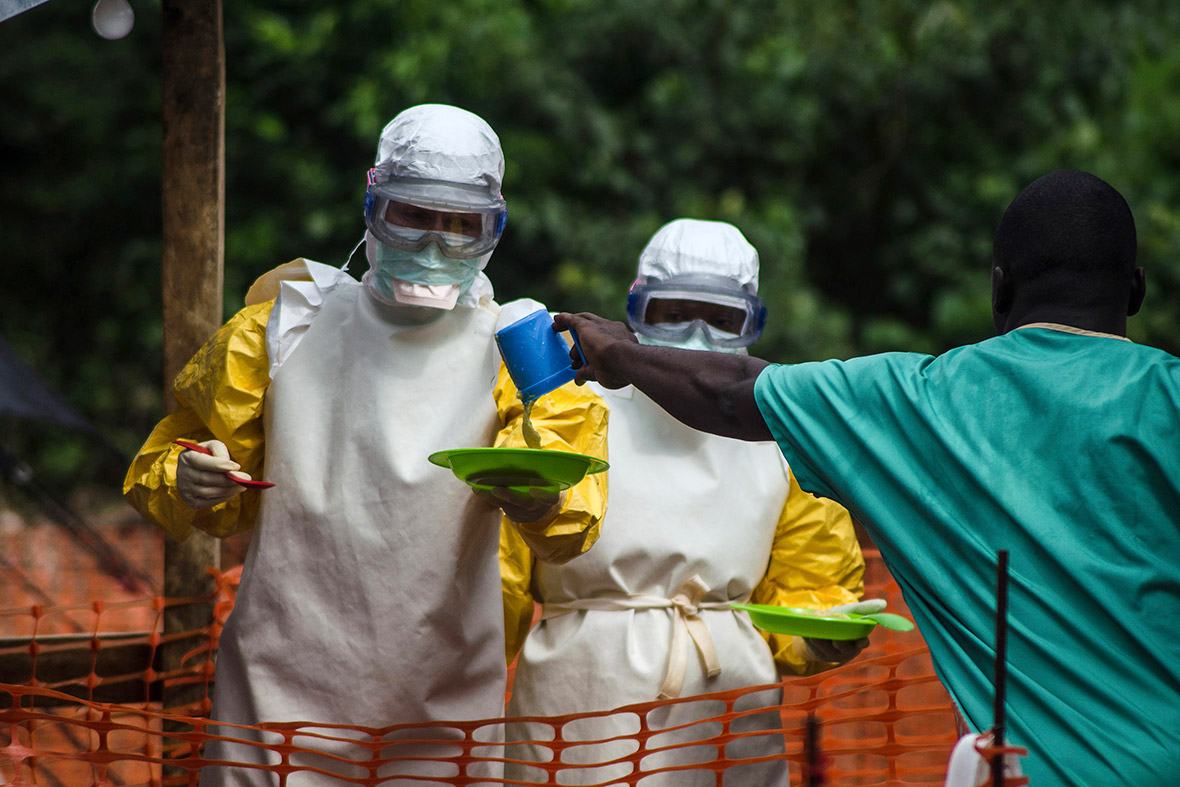
Medical
staff working with Medecins sans Frontieres prepare to take food to
patients kept in an isolation area in Kailahun. Sierra Leone now has the
highest number of Ebola cases, at 454, surpassing neighbouring Guinea where the outbreak originated in February.Reuters Four vaccines being developed in the US against the Ebola virus are stuck in various stages and for various reasons, money being the most prominent one.
The most promising one is stuck in safety testing for the simple reason there is no money for a vaccine that has no market. Most big pharmaceuticals do not like to sink assets into developing any drug with low potential. That leaves the playing ground largely to the government and small, niche companies.
"I don't see why anybody except the U.S. government would get
involved in developing these kinds of countermeasures," said Dr Sina
Bavari of the US Army Medical Research Institute of Infectious Diseases
(USAMRIID) in Frederick, Maryland. "There is no market in it."
As nations across the world step up vigil at airports and entry points, Ebola has claimed the life of yet another doctor, this time in Sierra Leone. Dr Sheik Humarr Khan was overseeing Ebola treatment at Kenema Government Hospital, about 185 miles east of Sierra Leone's capital city, Freetown.
Ebola virus has infected more than 1,200 people and killed close to
700 so far. While the doctor who led the fight against the virus died
earlier on, two American charity members, including a doctor, are being
treated for Ebola and said to be deteriorating.
Ebola has claimed the life of another doctor, this time in Sierra Leone.
The fatality rate of the current outbreak is around 60%. Patients can
survive under proper care. However, all that patients are getting as
treatment are painkillers and liquid replacements to tackle dehydration, besides antibiotics for secondary infections.
There is no cure for Ebola, not unless the vaccines proceed further in human testing.
Money is not the only hurdle in vaccine development. Taking the vaccine from animal testing to humans is a big leap. It is difficult to find enough people at high risk to test it, unlike a common flu or HIV.
"There are at least four vaccines that can protect against Ebola (in monkeys)," says Dr Thomas Geisbert, whose lab at the University of Texas Medical Branch is working on some of them. "But how do you take this to the next level?"
Drugs have been grown on genetically engineered tobacco. Called
MB-003, it provided 100% protection to monkeys when given right after
exposure to the virus, and helped even after symptoms developed.
Vaccines using a virus called vesicular stomatitis have been genetically engineered to resemble Ebola
and have worked well in monkeys. Scientists are confident about its
efficacy but as it uses a "live" virus, there are the safety concerns.
There have also been vaccines using virus-like particles, an approach that's worked against other diseases. But again, testing has not yet been done in people.
A drug being tested for influenza, favipiravir or T-705 has shown that it may be effective against Ebola in mice. The USAMRIID is currently testing it against monkeys, animals whose response to Ebola infections is much closer to humans than that of mice.
The lab is also testing a drug called BCX4430 in animals. A small biotech company called BioCryst is working with USAMRIID to develop that one.
Experts are however divided on the question of using experimental
drugs during an outbreak of the disease. Some believe that the vaccines should be used on lab and health workers on the front line of the battle against Ebola. Others do not like to take chances.
Hopefully, the current outbreak will give the desired impetus to drug research in the area.
ibtimes.co.uk - Ebola Vaccines: Poor
Market Potential and Lack of Subjects for Clinical Trials
Holding Up Testing
|
|
|
 Primer
Primer
 Anterior
2 a 3 de 3
Siguiente
Anterior
2 a 3 de 3
Siguiente
 Último
Último

|
|
|
|
De: Marti2 |
Enviado: 18/08/2014 04:04 |
Ebola drug derived from GM tobacco could cause cancer, elephantiasis and other serious side effects
Learn more: http://www.naturalnews.com/046489_Ebola_drugs_GM_tobacco_cancer.html#ixzz3AiGYxSyH
(NaturalNews) Now that the mainstream media has planted the seeds of
fear with regard to the stateside spread of Ebola, the stage is set for
the eventual release of Ebola drugs and vaccines to supposedly combat
this deadly illness. But experimental drugs already administered to two
American aid workers, which contain genetically modified (GM) monoclonal
antibodies, pose the threat of cancer, elephantiasis and other serious
side effects, according to research.
Known as ZMapp, an
experimental Ebola drug containing derivatives of GM tobacco bears
resemblances to earlier experimental drugs that used the same technology
-- and that failed miserably. One experimental drug given to patients
at Northwick Park Hospital in London back in 2006 resulted in one man
having his head swell, and several others developing signs of cancer.
Three others, according to The Sunday Times,
were told that they had an extremely high likelihood of developing
incurable autoimmune diseases from the drug, known as TGN1412, which
contained GM monoclonal antibodies. The side effects from the drug, made
by a Germany-based firm, were so dramatic, in fact, that it was quickly
dubbed the "Elephant Man drug," in reference to a participant whose
head essentially blew up.
"Victims of the disastrous 'Elephant
Man' drugs trial have been told they face contracting cancer and other
fatal diseases as a result of being poisoned in the bungled tests,"
wrote David Leppard for The Times. "One of the six victims was told last week he is already showing 'definite early signs' of lymphatic cancer. ... [The men] suffered heart, liver and kidney failure and were left seriously ill."
Earlier
trials on other GM monoclonal antibody drugs had similar outcomes, with
patients developing extreme side effects, some of which were permanent.
In each case, the experimental drug
in question was initially said to have the potential for healing, but
once applied to actual humans turned out to have disastrous health
consequences, which may also be true for Ebola drugs cut from the same
cloth.
GM proteins will always wreak havoc in humans At
no point have GM monoclonal antibodies ever been successful in human
trials, as they are, by their very nature, incompatible with the human
immune system. Using synthetic proteins that exist nowhere in nature to
trigger some kind of positive immune response by the body is human pride
and arrogance at its pinnacle -- a loathsome attempt at playing God
that appears to always result in catastrophic biological damage.
Based
on what we already know about GM monoclonal antibody technology, the
human body systematically rejects it. Part of this rejection involves
damaging the immune system in such a way that it basically attacks
itself -- this is known as autoimmunity -- leading to cellular, organ,
and other extreme damage that is typically irreversible
In the case of GM monoclonal antibodies for Ebola, GM tobacco
plants are being used as a biological manufacturing facility for the
foreign proteins that wreak this type of havoc. A complex process
instructs GM tobacco plants to produce the proteins, which are then
refined and administered to humans, leading to unknown effects.
"A gene is inserted into a virus that is then used to infect the tobacco plant," wrote Sharon Begley for Reuters about the process. "The virus acts like a micro-Trojan Horse, ferrying the engineered DNA into the plant."
"Cells
infected with the virus and the gene it is carrying produce the target
protein. The tobacco leaves are then harvested and processed to extract
the protein, which is purified."
A full account of the damage potential of GM monoclonal antibodies is available at the Institute of Science in Society: I-SIS.org.uk.
Sources for this article include:
http://www.gmwatch.org
http://www.gmwatch.org
http://www.i-sis.org.uk
http://www.reuters.com
http://science.naturalnews.com
|
|
|
|
|
|
De: Marti2 |
Enviado: 18/08/2014 04:06 |
Monsanto
y el Departamento de Defensa de EE.UU. están financiando a
una empresa farmacéutica que podría ganar miles de millones de
dólares con el tratamiento
del Ébola.
Tekmira Pharmaceuticals, una
empresa que trabaja en un fármaco contra el Ébola, acaba de recibir
una inyección 1,5 millones de dólares en efectivo, procedentes de
Monsanto.
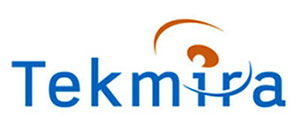
Se ha informado públicamente que la inversión de Monsanto está
relacionada con tecnología desarrollada por Tekmira en el campo de
la agricultura. El acuerdo total está valorado en 86,2 millones de
dólares.
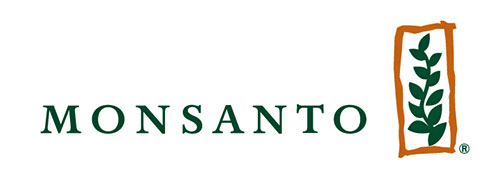
Por otra parte, Tekmira tiene un contrato de 140 millones de dólares
con los militares de EE.UU. para desarrollar medicamentos para el
tratamiento del Ébola.
Las webs conspirativas pueden ponerse las botas con este asunto y
las oportunas relaciones comerciales entre estas entidades justo en
este momento.
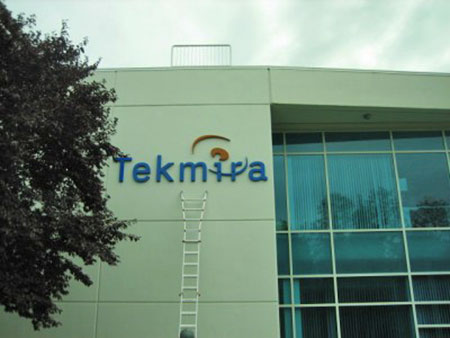
Pero la realidad incontrovertible es que vivimos el brote más
importante de Ébola de la historia y el más publicitado por los
medios, hecho que podría crear una gran demanda en el mercado
farmacéutico si el virus traspasa las fronteras africanas y llega a
los países ricos occidentales.
Lamentablemente, la historia de la medicina revela que las compañías
farmacéuticas, la CDC y la OMS han exagerado en varias ocasiones la
severidad de los brotes epidémicos con el fin de promover la venta
de medicamentos para su tratamiento.
No sabemos si este es el caso, pero pensarlo no es nada
descabellado.
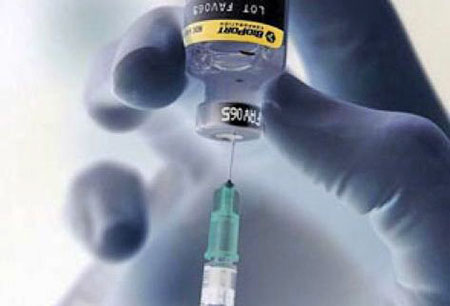
Ahora que el virus del Ébola puede, hipotéticamente, convertirse en
una amenaza para occidente, pueden empezar a producirse fuertes
inversiones en el desarrollo de una vacuna, pues su venta ya sería
un negocio.
Recordemos que cuatro vacunas que se estaban desarrollando en los
EE.UU. contra el virus del Ébola, llevan paralizadas desde hace
tiempo y el dinero parece haber sido la clave del asunto.
La vacuna más prometedora se quedó atascada en la etapa de pruebas
de seguridad, por la sencilla razón de que no había dinero para una
vacuna que no tenía mercado, es decir, que afectaba solo a países
pobres que no podían pagarla.
A la mayoría de
las grandes farmacéuticas no les gusta invertir
activos en el desarrollo de fármacos con bajo potencial de negocio.
Eso dejaba el desarrollo de estas vacunas en manos de los gobiernos
y en pequeñas empresas.
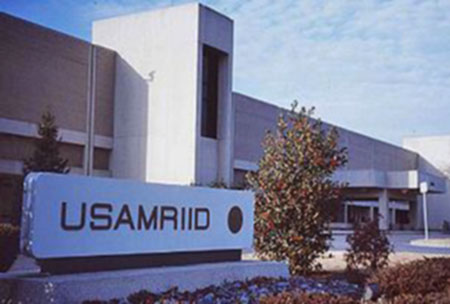
"No veo por qué nadie, excepto el
gobierno de EE.UU. se involucraría en el desarrollo de este tipo
de medidas", dijo la Dra. Sina Bavari del Instituto del Ejército
de EE.UU. de Investigación Médica de Enfermedades Infecciosas (USAMRIID)
en Frederick, Maryland.
"No existe un mercado para esto"
La tasa de letalidad del brote actual del
Ébola es de alrededor del 60%, aunque los pacientes pueden
sobrevivir si reciben el cuidado adecuado.
Sin embargo, lo único que los pacientes
están recibiendo como tratamiento son analgésicos y reemplazo de
líquidos para hacer frente a la deshidratación, además de
antibióticos para las infecciones secundarias.
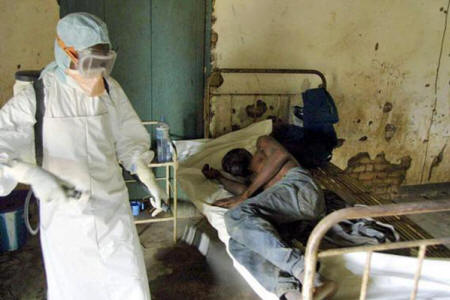
No hay cura para el Ébola, a menos que las vacunas avancen más en
las pruebas en humanos. El dinero no es el único obstáculo en el
desarrollo de vacunas. Pasar de la experimentación con animales a
los seres humanos representa un gran salto.
Es difícil encontrar suficientes
personas en estado de alto riesgo para probarlas, a diferencia de
enfermedades como la gripe común o el VIH.
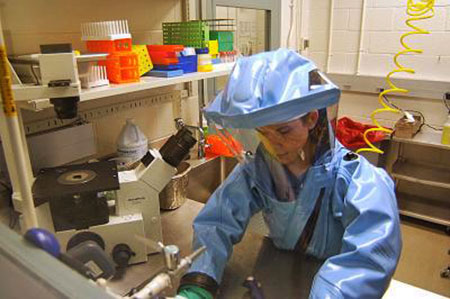
"Hay por lo menos cuatro vacunas que
pueden proteger contra el Ébola (en monos)", dice el Dr. Thomas
Geisbert, cuyo laboratorio en la Universidad de Texas Medical
Branch está trabajando en alguna de ellas.
"Pero, ¿cómo llevar esto al
siguiente nivel?"
Llamada MB-003, esta vacuna proporciona
una protección del 100% a los monos cuando se administra
inmediatamente después de la exposición al virus, y ayudó incluso
después de que se desarrollara los síntomas.
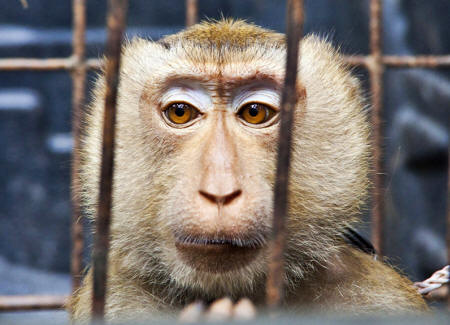
Las vacunas que usan el virus de la estomatitis vesicular han sido
diseñadas genéticamente para asemejarse al Ébola y han funcionado
bien en monos.
Los científicos confían en su eficacia,
pero al utilizar un virus "vivo", existen ciertos problemas de
seguridad. También se han producido vacunas utilizando partículas
similares al virus, un enfoque que ha funcionado contra otras
enfermedades.
Pero, de nuevo, las pruebas aún no se
han hecho en seres humanos.
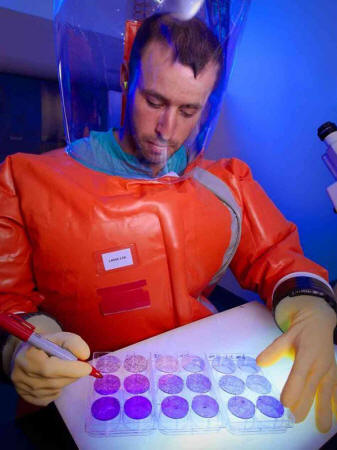
Un fármaco que está siendo probado para la influenza, el
favipiravir
o T-705 ha demostrado que también puede ser eficaz contra el Ébola
en ratones.
El USAMRIID lo está probando actualmente
en monos, animales cuya respuesta a las infecciones del Ébola es más
cercana a la de los seres humanos. El laboratorio también está
probando una droga llamada BCX4430 en animales.
Una pequeña empresa de biotecnología
llamada
BioCryst está trabajando con USAMRIID para desarrollarla.
Sin embargo los expertos están divididos sobre la cuestión de la
utilización de medicamentos experimentales durante un brote de la
enfermedad. Algunos creen que las vacunas se deben aplicar a los
trabajadores del laboratorio y de la salud en primera línea de
batalla contra el Ébola. A otros no les gusta correr riesgos.
Lo cierto pero, es que ante la posibilidad de realizar un gran
negocio, la vacuna puede recibir las inversiones necesarias para ser
desarrollada, justo en este momento.
Y probablemente, tales inversiones no serán destinadas a pequeños
laboratorios o entidades públicas, sino a grandes empresas del
sector sanitario y a grandes farmacéuticas.
Atentos al desarrollo de los acontecimientos…
|
|
|
|
|
| |
|
|
©2025 - Gabitos - Todos los derechos reservados | |
|
|

